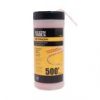Some of these posts show people have never pulled though conduit. Fishtape, fish sticks, etc always bind in conduit (depending on size) unless you have a metric S* ton of lube.
My go to depending on conduit width and thickness because whoever installed it didn't preinstall a pull string (always an a* hole somewhere)...
Option 1: Magna Pull - this tool is amazing and works though conduit side walls. Attach your pull string to the tail and start dragging. This method only works if all conduit is exposed. I've posted before in the tool section about this tool!
I've meant to post about this in the past but always forget to take a picture when I have it in use. This tool is awesome for vertical or horizontal pulls/runs. It will pull though insulation without a problem. Basically you have a strong/rare earth type bullet magnet and just as powerful...

ipcamtalk.com
Option 2: depending on length - get your big shop vac out and goto one end with all inspection ports closed tight. Goto one end and get all your pull string out off the roll so there is no friction holding it back. Get several tissues or some TP and tie it in a wad and shove it in, then turn the vacuum on at the other end. the suction will pull that string attached to the TP or tissue paper all the way down to the other end.
Fish tapes require a lot of liquid lube in order to note bind up and I hate pulling a fish tape back out covered in that snot so I turn to the two options above when ever possible.




